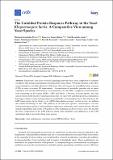Por favor, use este identificador para citar o enlazar a este item:
http://hdl.handle.net/10261/188542COMPARTIR / EXPORTAR:
 SHARE SHARE
 CORE
BASE CORE
BASE
|
|
| Visualizar otros formatos: MARC | Dublin Core | RDF | ORE | MODS | METS | DIDL | DATACITE | |

| Título: | The unfolded protein response pathway in the yeast Kluyveromyces lactis. A comparative view among yeast species |
Autor: | Hernández-Elvira, Mariana; Torres-Quiroz, Francisco; Escamilla-Ayala, Abril; Domínguez-Martín, Eunice CSIC; Escalante, Ricardo CSIC ORCID ; Kawasaki, Laura; Ongay-Larios, Laura; Coria, Roberto | Palabras clave: | Yeast Endoplasmic reticulum Stress UPR Ire1 Hac1 Kar2 |
Fecha de publicación: | 2018 | Editor: | Multidisciplinary Digital Publishing Institute | Citación: | Cells 7(8): 106 (2018) | Resumen: | Eukaryotic cells have evolved signalling pathways that allow adaptation to harmful conditions that disrupt endoplasmic reticulum (ER) homeostasis. When the function of the ER is compromised in a condition known as ER stress, the cell triggers the unfolded protein response (UPR) in order to restore ER homeostasis. Accumulation of misfolded proteins due to stress conditions activates the UPR pathway. In mammalian cells, the UPR is composed of three branches, each containing an ER sensor (PERK, ATF6 and IRE1). However, in yeast species, the only sensor present is the inositol-requiring enzyme Ire1. To cope with unfolded protein accumulation, Ire1 triggers either a transcriptional response mediated by a transcriptional factor that belongs to the bZIP transcription factor family or an mRNA degradation process. In this review, we address the current knowledge of the UPR pathway in several yeast species: Saccharomyces cerevisiae, Schizosaccharomyces pombe, Candida glabrata, Cryptococcus neoformans, and Candida albicans. We also include unpublished data on the UPR pathway of the budding yeast Kluyveromyces lactis. We describe the basic components of the UPR pathway along with similarities and differences in the UPR mechanism that are present in these yeast species. | Versión del editor: | https://doi.org/10.3390/cells7080106 | URI: | http://hdl.handle.net/10261/188542 | DOI: | 10.3390/cells7080106 | E-ISSN: | 2073-4409 |
| Aparece en las colecciones: | (IIBM) Artículos |
Ficheros en este ítem:
| Fichero | Descripción | Tamaño | Formato | |
|---|---|---|---|---|
| unfoldspec.pdf | 2,38 MB | Adobe PDF |  Visualizar/Abrir |
CORE Recommender
PubMed Central
Citations
20
checked on 23-abr-2024
SCOPUSTM
Citations
24
checked on 28-abr-2024
WEB OF SCIENCETM
Citations
16
checked on 26-feb-2024
Page view(s)
134
checked on 02-may-2024
Download(s)
54
checked on 02-may-2024

